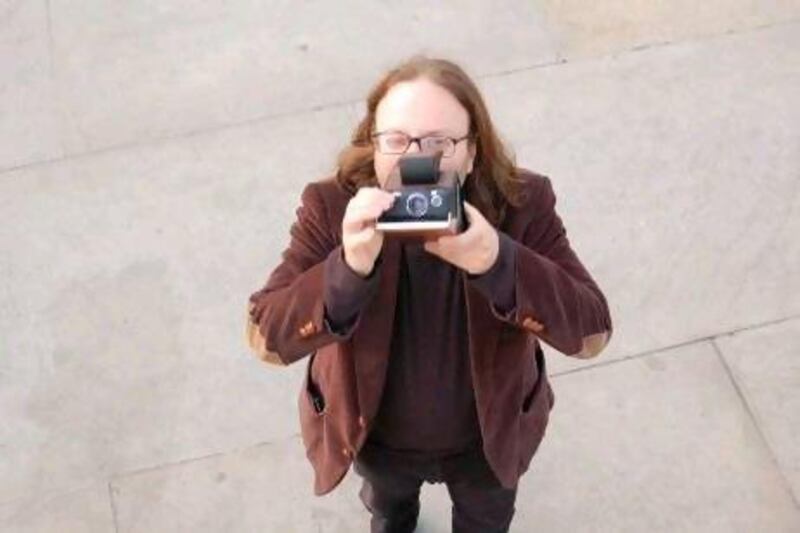Remember the Polaroid? You could be forgiven for thinking of the clunky 1970s camera that spat out “instant” prints as a format that, in our brave new digital world, was as obsolete as the windup gramophone.
But SF Said, a Beirut-born writer and photographer, proves the medium is not only alive, but thriving. He’s about to have his first exhibition of Polaroids, all of them London landscapes, in the high-spending environs of Maggs antiquarian booksellers, in London’s Mayfair.
His love of Polaroid is not about a 1970s aesthetic. “It’s got nothing to do with nostalgia,” he says. He gestures towards a picture in the show: “The 1970s did not look like that. To me, that looks like a dream or a memory. There is something in the colours and textures of Polaroid that I don’t think any other type of camera comes close to. It’s pure magic.”
Said’s pictures do seem touched by magic. They’re unconventional, with notable “flaws” in the exposure, but possess an unsettling sense of mystery that will stop you in your tracks.
"When I first saw them they blew me away," says Carl Williams, the curator of the exhibition at Maggs. "SF has captured a side of London, a particular psychology of the city, which is all to do with things you know but can't quite remember. They have a sense of the uncanny, what Freud called unheimlich. It's very hard to deal in this feeling, but SF really gets it."
The pictures were taken for a book, London's Lost Rivers, by Tom Bolton, published last year. Even native Londoners are often unaware that London is underscored by several waterways, such as the Fleet, the Tyburn and the Westbourne.
Said and Bolton trudged around with an aquatic map of the city to research the book — a map that a 19th-century Londoner would have been familiar with but that has long since fallen out of use. Rather like the Polaroid.
The exhibition also includes the photographic work of Jon Savage, the foremost historian of punk counter-culture in the 1970s, who wrote the acclaimed England’s Dreaming. Together, their pictures are a poetic, deeply felt response to forgotten London: edgelands, derelict sites, empty riverbanks, alleyways and tunnels.
“I find it wonderful that London is a kind of palimpsest, that it contains all these layers of history and experience,” says Said. “The lost rivers project was a perfect way into that. I am fascinated by the idea that landscapes might have memories or dreams.”
Polaroid, more than any other format, is perfectly suited to capturing this. It seems to scrabble away at the surface of things, trying to locate the intangible and invisible. Said uses a second-hand SX-70, a classic model first made in 1972, and scours dusty old pharmacies and eBay to buy expired film. New film is available again, thanks to the Impossible Project in New York, which saved Polaroid’s last factory at the 11th hour in 2010, but the quality, says Said, is not quite there yet.
Said loves expired film, particularly in a range thrillingly titled Time Zero. Far from ruining an image, its ageing, unstable chemicals contribute to the dreamlike quality of his pictures. Leaking colours; blurring; unexposed corners; flame-like flashes of light across the surface; smoky shades of mauve and turquoise: Said uses them all to artistic effect. River Walbrook looks apocalyptic. Flames lick the landscape as night workers sweep snow from the streets. River Fleet, meanwhile, has a ghostly, Victorian, intensely melancholic quality. “With Polaroid, the camera and the film play as big a part as you do, and sometimes they know better than you,” says Said.
Said is passionate about photography and “the viability of the analogue form”, but he isn’t a professional. The camera is something he picks up as “an escape from words, writing and editing”. After a spell in academia at Cambridge University, he enjoyed a successful career as an arts journalist for The Daily Telegraph, before leaving to devote his time to children’s books. His first two, Varjak Paw and The Outlaw Varjak Paw, about an urban Mesopotamian cat with magical powers, won several awards and favourable reviews in the British and American press. The story has since been optioned by the Jim Henson Company, of Muppets fame. Said has just completed his third book, Phoenix, a “sci-fi space epic for all ages”, which will be out next year.
Said was born in Beirut in 1967, and lived in Jordan until he was two. When his parents parted, he moved to London with his mother. His ethnic background is a mixture of Iraqi, Egyptian, Turkish and Circassian, but London is where he feels “completely at home”. Even so, the Middle East has played an important part in his life. Said even became a speech writer for the Crown Prince of Jordan at a time when, he wistfully recalls, “peace in the Middle East looked like a real possibility”.
His grandparents ended up living between Abu Dhabi and Dubai, and Said still visits the Gulf frequently. He is fascinated by its “oldness and newness”, its “transient, mirage-like” nature.
He is working on a Polaroid project of the area and says that in Dubai, “you sometimes feel as if you are looking at a parallel world. I love the Burj Al Arab. I could stare at it for hours. A skyscraper in the shape of a sail on a dhow. What an amazing idea. And a great subject for Polaroid.”
From the Westbourne to the Wandle: the Photographs of SF Said and Jon Savage, is at Maggs Bros, 50 Berkeley Square, London, from March 22 to April 19
Follow
Arts & Life on Twitter
to keep up with all the latest news and events
[ @LifeNationalUAE ]





